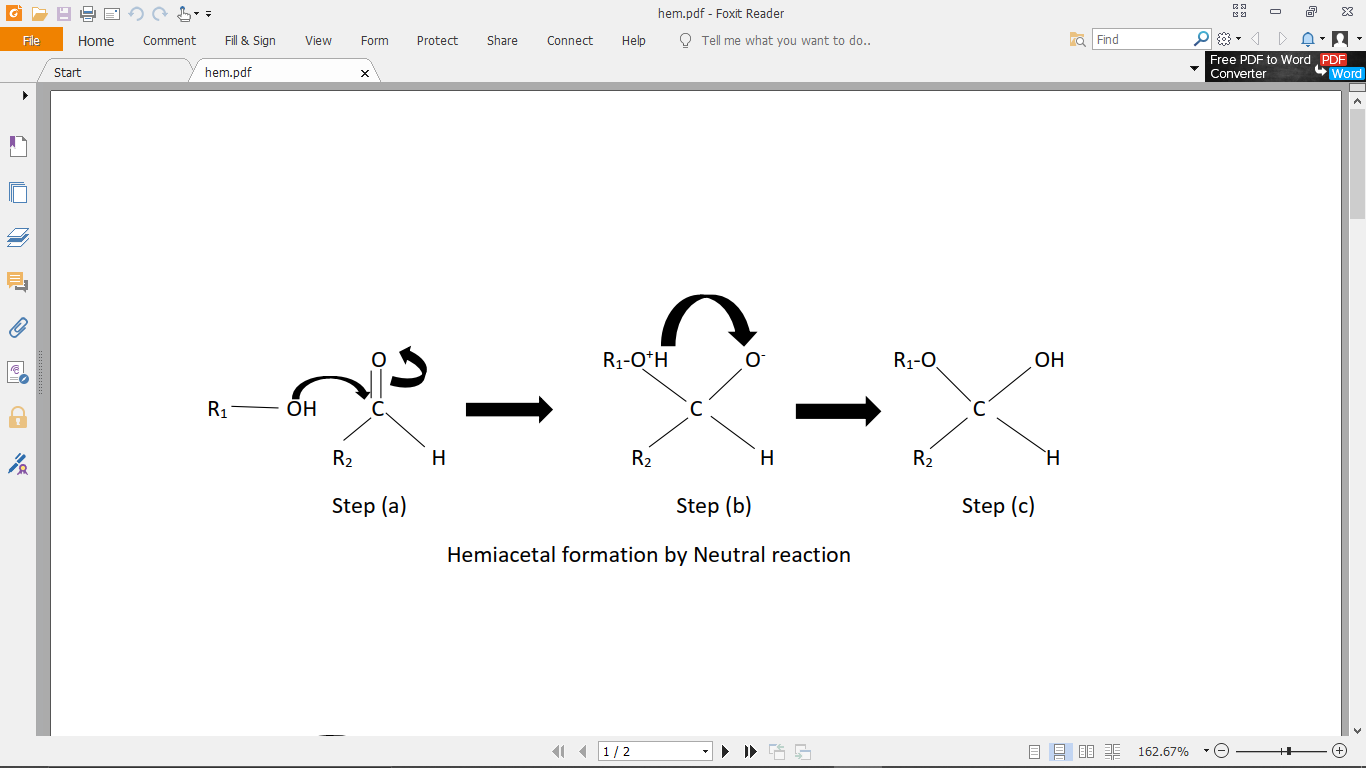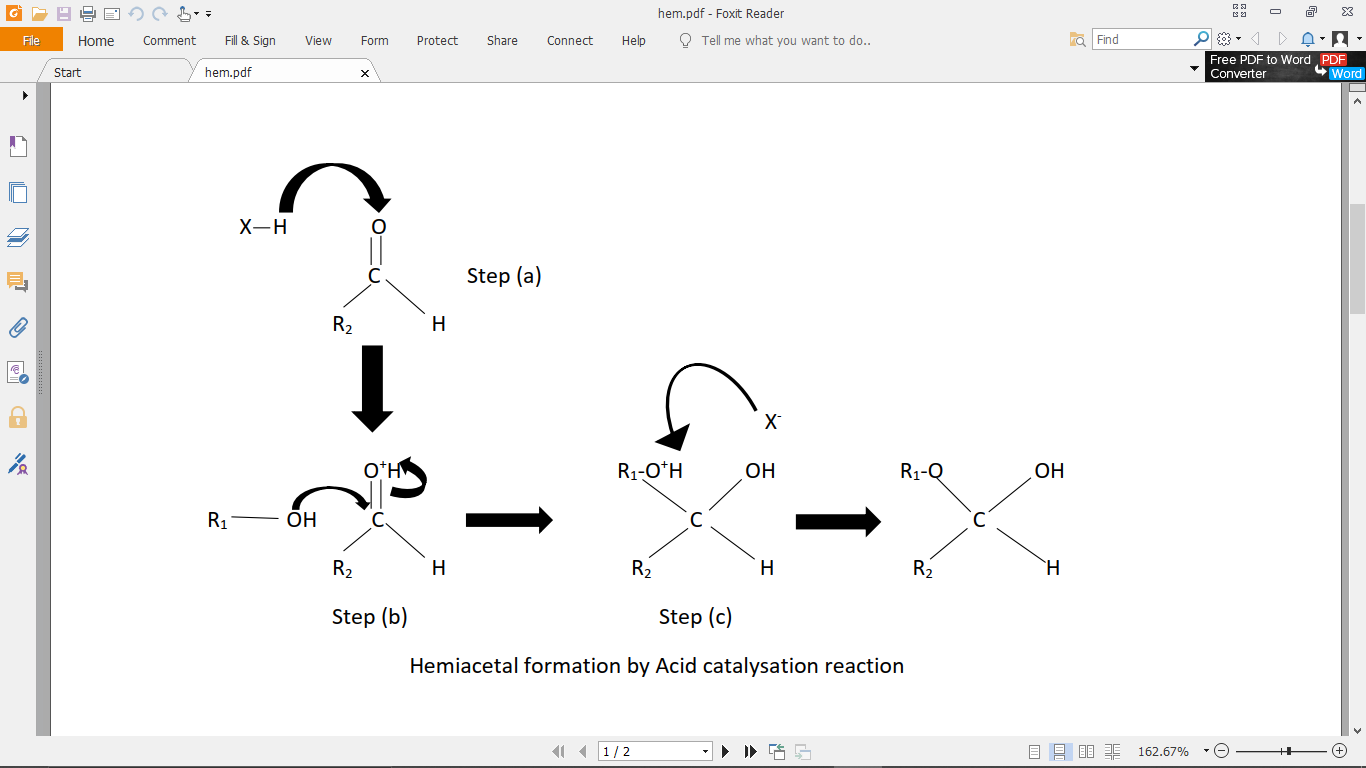
What is meant by hemiacetal? Give an example of a reaction (with mechanism) showing its formation.
Answer
476.7k+ views
Hint: A hemiacetal which is taken from a Greek word ‘hemi’ which means half, is formed when an aldehyde reacts with an alcohol. This can be done either through a neutral reaction or through an acid catalysed reaction.
Complete step by step answer:
A hemiacetal is a carbon compound where the central carbon atom is connected to four different molecules, compound or atoms. One of them is an alcohol $\left( { - OH} \right)$ group, the other is an ether $\left( { - OR} \right)$ group. Among rest two, one is an alkyl group denoted by ${\text{R}}$, and other is a hydrogen atom $\left( { - H} \right)$. Here, the carbon chain ${\text{R}}$ can be of any length.
The mechanism of formation of a hemiacetal:
Step (1): Through the neutral reaction mechanism: It involves only the aldehyde, and the alcohol. The steps are shown in the figure below.

(a) First, the alcohol attacks the carbonyl carbon of the aldehyde.
(b) The pi-electrons from the double bond between the carbon, and oxygen go to the oxygen atom, making oxygen atom negatively charged, and carbon atom positively charged.
(c) The extra proton on the alcohol group which got attached is then transferred to the negatively charged oxygen, and forms the hemiacetal.
Step (2): Through the acid catalysed mechanism: It involves the catalyzation of aldehyde first. The steps are shown in the figure below.

(a) First, the acidic hydrogen from the acid $\left( {X - H} \right)$ attacks the lone pair of oxygen in the aldehyde. This puts a positive charge on the oxygen atom of the aldehyde.
(b) The positive charge on the electronegative atom, oxygen is highly unstable, so, the pi-bond between the oxygen, and carbon of the aldehyde breaks, and the electron neutralises the positive of the oxygen atom. This creates a positive charge on the carbonyl carbon as shown in figure (b). Now, the alcohol being nucleophilic in nature, attacks the positive carbon centre.
(c) The extra proton on the alcohol is then taken by the conjugate base of the acid used in step (a), that is $\left( {X - H} \right)$. Hence, hemiacetal is formed.
Note:
For effective formation, acid catalyzation gives faster results because without it, the extra electron of the oxygen after the alcohol attack, can go back to form the double bond giving back the initial product. That’s why neutral reaction is a slow step reaction.
Complete step by step answer:
A hemiacetal is a carbon compound where the central carbon atom is connected to four different molecules, compound or atoms. One of them is an alcohol $\left( { - OH} \right)$ group, the other is an ether $\left( { - OR} \right)$ group. Among rest two, one is an alkyl group denoted by ${\text{R}}$, and other is a hydrogen atom $\left( { - H} \right)$. Here, the carbon chain ${\text{R}}$ can be of any length.
The mechanism of formation of a hemiacetal:
Step (1): Through the neutral reaction mechanism: It involves only the aldehyde, and the alcohol. The steps are shown in the figure below.

(a) First, the alcohol attacks the carbonyl carbon of the aldehyde.
(b) The pi-electrons from the double bond between the carbon, and oxygen go to the oxygen atom, making oxygen atom negatively charged, and carbon atom positively charged.
(c) The extra proton on the alcohol group which got attached is then transferred to the negatively charged oxygen, and forms the hemiacetal.
Step (2): Through the acid catalysed mechanism: It involves the catalyzation of aldehyde first. The steps are shown in the figure below.

(a) First, the acidic hydrogen from the acid $\left( {X - H} \right)$ attacks the lone pair of oxygen in the aldehyde. This puts a positive charge on the oxygen atom of the aldehyde.
(b) The positive charge on the electronegative atom, oxygen is highly unstable, so, the pi-bond between the oxygen, and carbon of the aldehyde breaks, and the electron neutralises the positive of the oxygen atom. This creates a positive charge on the carbonyl carbon as shown in figure (b). Now, the alcohol being nucleophilic in nature, attacks the positive carbon centre.
(c) The extra proton on the alcohol is then taken by the conjugate base of the acid used in step (a), that is $\left( {X - H} \right)$. Hence, hemiacetal is formed.
Note:
For effective formation, acid catalyzation gives faster results because without it, the extra electron of the oxygen after the alcohol attack, can go back to form the double bond giving back the initial product. That’s why neutral reaction is a slow step reaction.
Recently Updated Pages
Master Class 11 Accountancy: Engaging Questions & Answers for Success

Express the following as a fraction and simplify a class 7 maths CBSE

The length and width of a rectangle are in ratio of class 7 maths CBSE

The ratio of the income to the expenditure of a family class 7 maths CBSE

How do you write 025 million in scientific notatio class 7 maths CBSE

How do you convert 295 meters per second to kilometers class 7 maths CBSE

Trending doubts
Which are the Top 10 Largest Countries of the World?

What is a transformer Explain the principle construction class 12 physics CBSE

Differentiate between homogeneous and heterogeneous class 12 chemistry CBSE

Draw a labelled sketch of the human eye class 12 physics CBSE

What are the major means of transport Explain each class 12 social science CBSE

What is the Full Form of PVC, PET, HDPE, LDPE, PP and PS ?




